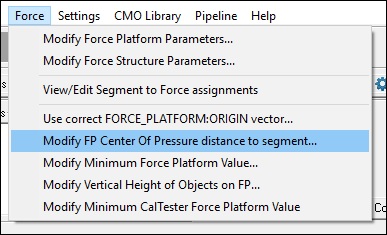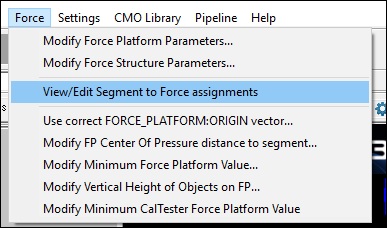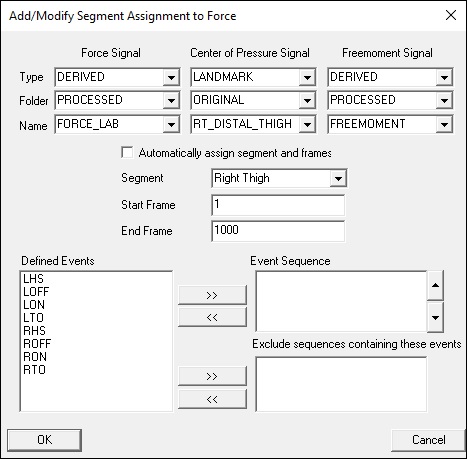Force Assignment
| Language: | English • français • italiano • português • español |
|---|
Assignment of Force signals to a Visual3D segment
Visual3D assigns segments to force platforms based on the estimated contact of a segment with the force platform. Contact is estimated by comparing the path of the center of mass of the segment with the center of pressure on the force platform.
The assignment allows the user to compute the ground reaction force and center of pressure based on specifying a segment rather than the force platform. For example, it is possible to create a report graph for the GRF and COP under the right foot. This means that the user doesn't have to document which segment hit which force platform.
When a segment is created in Visual3D, signals are created that contain, at each frame of contiguous COP values, the distance from the center of mass of each segment to the center of pressure from all Force Platforms/Structures. The mean value of each of these signals is computed. The segment with the smallest mean distance is is assigned the force.
KINETIC_KINEMATIC Forces
If one or more forces are assigned to a segment 3 resultant signals are created.
- Force_n - Assigned Forces
- COP_n - Assigned Center of Pressure
- Free_Moment_n - Assigned Free Moment
COP Distance to Segment
The COP Distance is a threshold distance that must be satisfied in order to identify a force assignment.
If the distance is too small, and the COP error is a little too high, a recognizable assignment might not be made.
The default value of 0.2m has proven to be an acceptable value, so users should refrain from modifying this value unless they have a very good reason.
Automatic_Gait_Events
Automatic_Gait_Events are based on the force assignments, so if your assignments are bad, or don't exist, the gait events will be incorrect.
It is extremely important that users check the assignments carefully. This is one of the most serious challenges to users that would like to have one pipeline process all of the data automatically. The pipeline should always pause after the model template has been applied and the movement trials assigned to the model. This is the time when the force assignments should be "cleaned up". If you compute the automatic gait events before the cleanup, your event labels will be junk.
Assigned forces using Evaluate_Expression
Evaluate_Expression for assigned forces
Updating Assigned Forces Warning
The automatic force assignments are computed on Recalc. If the forces are modified by either changing the parameter or by processing the signals, the force assignments are not updated until Recalc.
Manual Assignment
Under the Model menu is an option to View/Edit Segment to Force assignments. This allows the user to check that forces have been applied to the appropriate segments for the appropriate number of frames. If, for example, only a partial contact is made between the foot and the force platform, the user should probably delete the force assignment.
Note: The dialog can only act on one active motion file. If more than one file are active (ALL_FILES or a TAG), the dialog will not appear
If the Event Label for contact with the force platform are not consistent with the force assignment, spurious results may be observed. It is always good practice, to verify that the force assignments make sense.
Pipeline Command
Assign_Segments_To_Force_And_COP
Remove_Segment_Assignment_To_Force_And_COP
External Forces
Force Platforms are commonly used for biomechanical analyses. In recent years with the introduction of robotics for rehabilitation and the desire to have patients supported during gait (e.g. walkers), we have had many requests to include force transducer data into the Inverse Dynamics calulations.
There are no general rules for specifying these external devices in the C3D file format, so we are making this up as we go along. At no point will we violate the C3D file format, but the C3D Parameters that we use may not be recognized by other manufacturers.
Example 1: Applying a force to a segment
You can apply recorded external forces to any segment in the model (except kinematic only segments).
The following dialog shows the properties of this command. The user is expected to enter signals (containing at least 3 components) in the Force, Center of Pressure, and Free Moment combo boxes. The Segment that the force is applied to and the frames at which the force should be applied.
The assignment can be edited by selecting the View/Edit Segment To Force Assignments option under the Model menu item.
Apply external forces (other than force plates) to any segment location.
Under the Model menu item is the option to "View/Edit Force assignments?. The user can apply any external force to a segment by providing the signal representing the force, the signal representing the Center of Pressure (which could be a landmark location on a segment), and a signal representing the free moment.
If the following message box pops up: You must have an active motion capture file and link model to view force platform assignments! it means that you have not selected an Active Movement File. To do this you must switch to Signal and Event processing mode and select the movement file. If you are in Model Builder mode or Workspace mode, there may not be an active file.
Transforming a signal from one coordinate system to another
Example 2: 3 DOF Force Transducer
Given an external force transducer that measures the 3 components of a force and streams the data as 3 analog channels; e.g the force transducer is a handle held in the hand.
- Create a 3 component vector from these 3 analog channels. In this example, the analog signals are scaled by a METRIC value.
- ! Create a scaled force signal in the Transducer Coordinate System
- Evaluate_Expression
- /EXPRESSION=VECTOR(ANALOG::ORIGINAL::CH1,ANALOG::ORIGINAL::CH2,ANALOG::ORIGINAL::CH3)*METRIC::PROCESSED::SCALE
- /RESULT_NAME=FORCE
- ! /RESULT_TYPE=DERIVED
- ! /RESULT_FOLDER=PROCESSED
- ;
- ! Transform the FORCE from the transducer coordinate system to the lab coordinate system
- Transform_Data_Coordinate_System
- /SIGNAL_TYPES= DERIVED
- /SIGNAL_NAMES= FORCE
- /SIGNAL_FOLDER= PROCESSED
- /FROM_SEGMENT_CS= TRANSDUCER
- /TO_SEGMENT_CS= LAB
- /RESULT_TYPE= DERIVED
- /RESULT_FOLDER= PROCESSED
- /RESULT_SUFFIX= _LAB
- ;
- ! For convenience, we create a FREEMOMENT signal that contains only zero's. The following
- ! will create the FREEMOMENT signal such that is has the same data rate and number of frames
- ! as the FORCE signal
- Evaluate_Expression
- /EXPRESSION=0*DERIVED::PROCESSED::FORCE_LAB
- /RESULT_NAME=FREEMOMENT
- /RESULT_TYPE=DERIVED
- /RESULT_FOLDER=PROCESSED
- ;
The signal FORCE_LAB can now be applied to a segment


